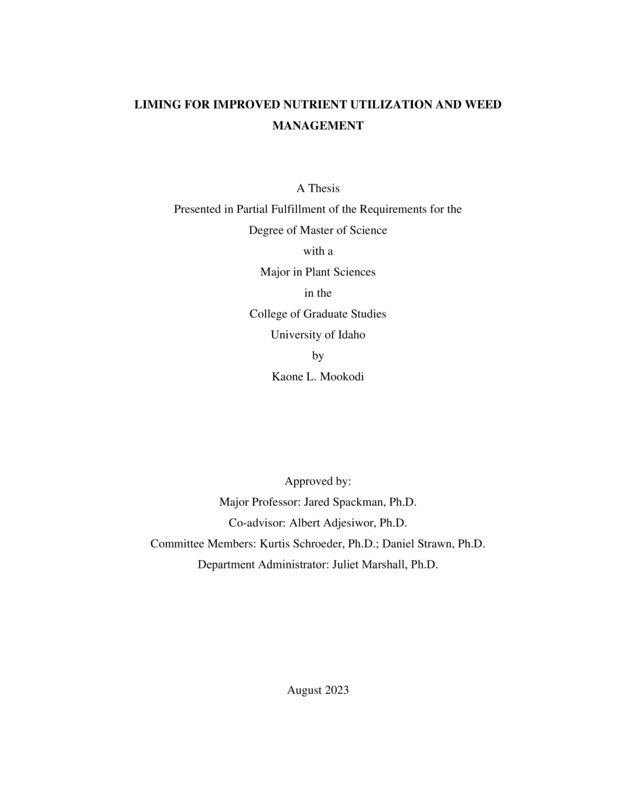LIMING FOR IMPROVED NUTRIENT UTILIZATION AND WEED MANAGEMENT
Mookodi, Kaone Lorraine. (2023-08). LIMING FOR IMPROVED NUTRIENT UTILIZATION AND WEED MANAGEMENT. Theses and Dissertations Collection, University of Idaho Library Digital Collections. https://www.lib.uidaho.edu/digital/etd/items/mookodi_idaho_0089n_12704.html
- Title:
- LIMING FOR IMPROVED NUTRIENT UTILIZATION AND WEED MANAGEMENT
- Author:
- Mookodi, Kaone Lorraine
- ORCID:
- https://orcid.org/0009-0009-3667-4780
- Date:
- 2023-08
- Keywords:
- plant health Soil chemistry soil health
- Program:
- Plant Sciences
- Subject Category:
- Soil sciences; Plant sciences
- Abstract:
-
Major yield setbacks due to invasive weed species population and soil acidity have been recorded in various regions of the United States. Estimated yield loss due to weed competition was approximately 12.3% in the Pacific Northwest. Similarly, it is estimated that there is a 40 to 70% reduction in yield when small grains are grown on acidic soils worldwide. One way to simultaneously improve the productivity of Idaho soils while increasing crop competitiveness is through liming. Agricultural lime applications increase soil pH which may improve crop competitiveness and make soil conditions unsuitable for certain weed species. Lime requirement (LR) analyses can be performed by reacting varying concentrations of lime with soil to provide calibrated equations for estimating how much lime is required to increase the pH of that soil to the desired level. Unfortunately, no known calibration testing has been conducted using soils from southern Idaho. The current University of Idaho and soil testing lab lime recommendations are based on testing mostly done in the 1980s on soils from Midwestern states, Washington, and northern Idaho. These calibrations do not reflect the climate or chemical and physical properties of acidic and trending acidic soils in southern Idaho. The overall aim for this paper was to evaluate the effect of liming acidic soils on soil properties, crop growth, and weed density, and b) to develop lime requirement equations for Idaho soils using lab incubations and field trial results. Generally, linear soil pH and Al responses were observed to lime rates, but there were no recorded significant effects on grain quality metrics or weed growth. Sikora (R2=0.99) and the Adams-Evans buffer (R2=0.92 to 0.97) methods were best suited for predicting the LR for Idaho soils compared to the calcium hydroxide buffer method (R2=0.02 to 0.11). The insights gained from this thesis on the potential benefits of lime application can be of great value to farmers and other stakeholders in Idaho's agricultural industry who seek to optimize crop yield and improve soil health.
- Description:
- masters, M.S., Plant Sciences -- University of Idaho - College of Graduate Studies, 2023-08
- Major Professor:
- Spackman, Jared; Adjesiwor, Albert
- Committee:
- Strawn, Daniel; Schroeder, Kurtis; Marshall, Juliet
- Defense Date:
- 2023-08
- Identifier:
- Mookodi_idaho_0089N_12704
- Type:
- Text
- Format Original:
- Format:
- application/pdf
- Rights:
- In Copyright - Educational Use Permitted. For more information, please contact University of Idaho Library Special Collections and Archives Department at libspec@uidaho.edu.
- Standardized Rights:
- http://rightsstatements.org/vocab/InC-EDU/1.0/

